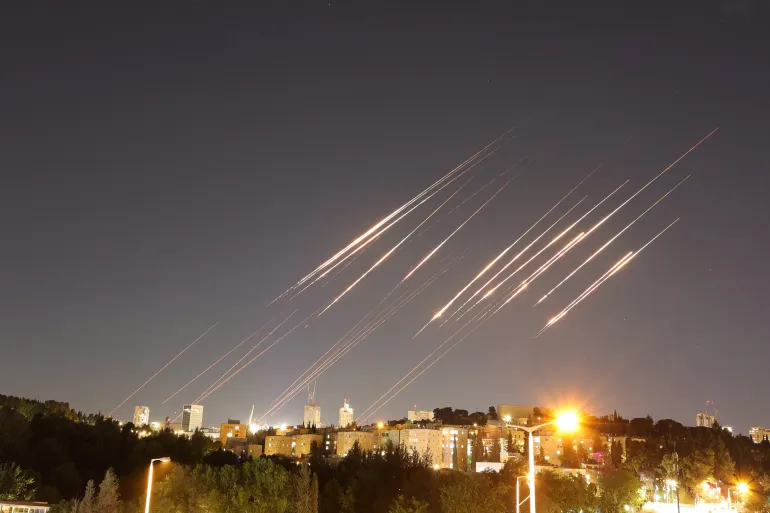1. High-Tech Weaponry: Missiles, Drones & AI
- Bunker-buster bombs & cruise missiles
The U.S. has deployed B-2 bombers carrying multiple 30,000‑lb GBU‑57 Massive Ordnance Penetrator “bunker-busters” and Tomahawks to obliterate Iran’s underground nuclear sites—Fordow, Natanz, and Esfahan—inflicting “extreme damage” on centrifuge facilities arxiv.org+14understandingwar.org+14wsj.com+14. - Iranian ballistic retaliation
In a dramatic response, Iran launched 22–30 liquid- and solid-fueled long-range ballistic missiles toward Israel, striking Haifa and Tel Aviv and demonstrating their precision strike capability windward.ai+7en.wikipedia.org+7nbcchicago.com+7understandingwar.org. - Drone swarms & loitering munitions
Tehran increasingly relies on UAV swarms—like the Shahed-136/Geran-2 loitering munitions enhanced with Russian GLONASS—to saturate air defenses and conduct asymmetric strikes nypost.com+2en.wikipedia.org+2nbcchicago.com+2en.wikipedia.org. - AI‑coordinated air defense
Israel counters with AI-powered command-and-control systems linking jets, interceptors, and drones for rapid, networked defense—a sophisticated electronic battlefield aviationfile.com.
2. Electronic Warfare: Jamming, Spoofing & Radar Blindness
- GPS jamming in the Strait of Hormuz
Since June 22, Iranian forces have carried out intense GPS jamming blocking satellite navigation for 900–1,100 ships daily, causing erratic vessel behavior, misreported positions (e.g. ships showing up overland), and even collisions like the one between Front Eagle and Adalynn ceobs.org+14porttechnology.org+14gcaptain.com+14. - Spoofing: stealth navigation distortion
Beyond jamming, Iran may spoof GNSS signals—broadcasting fake GPS data to mislead vessels into dangerous paths. Spoofing is stealthier than jamming, harder to detect, and can force misnavigation without obvious interference nbcchicago.com+2en.wikipedia.org+2en.wikipedia.org+2. - Radar and UAV uplink disruption
Both Iran and Israel deploy electronic warfare systems to blind enemy radars and jam drone control links. Iran targets Israeli UAV swarms; Israel, in return, employs AI-enabled EW to maintain air superiority theguardian.com+15aviationfile.com+15porttechnology.org+15.
3. Cyber Warfare: Banks, Bots & Disinformation
- Tehran’s disruptive cyber strikes
Iranian hackers have been mounting large-scale cyber campaigns: bank hacks (e.g., Bank Sepah), exploitive attacks on crypto exchanges, nationwide internet blackouts, and disinformation drives—all under escalating conflict cover washingtonpost.com+15politico.com+15secalliance.com+15. - Israel strikes back digitally
Israeli cyber forces have hit Iranian financial infrastructure, crippling exchanges like Nobitex and causing ~$90 million in losses. The U.S. Cyber Command has joined in protective and offensive operations en.wikipedia.org+6secalliance.com+6en.wikipedia.org+6politico.com. - Disinformation as combat
Iran and affiliated hacktivists deploy AI-generated fake news and social media memes to influence public opinion, destabilize societies, and shape global narratives en.wikipedia.org.
4. Strategy of Grey-Zone Escalation
- Maritime disruption, not total closure
Rather than closing the Strait outright, Iran opts for GPS disruption, mine-laying, drone shadowing, and coastal missile show-of-force—creating economic uncertainty without triggering full military retaliation ft.com+2understandingwar.org+2nypost.com+2intellinews.com+5thecipherbrief.com+5porttechnology.org+5. - Proxy & cyber symbiosis
Hackers and militia groups like Hezbollah coordinate for layered impact—kinetic strikes, cyber-hacks, and disinfo campaigns—maximizing pressure while minimizing overt war escalation .
5. Why This Matters
| Battlefield | Impact |
|---|---|
| Maritime Safety | Navigation chaos in Hormuz—routes rerouted, insurers hike premiums, supply chains disrupted gcaptain.com+3windward.ai+3en.wikipedia.org+3. |
| Economic Shockwaves | Oil prices surge past $100/bl on strait threats; global inflation risk climbed . |
| Tech Warfare Template | This conflict blends missiles, AI-enabled defense, electronic jamming, cyber warfare—setting a blueprint for future global conflict. |
6. Key Takeaways
- Electronic dominance matters
Control of the electromagnetic and cyber spectrum can debilitate navigation, blind radars, and tilt power without kinetic force. - Hybrid warfare is now mainstream
Future wars will mix bombs, bytes, drones, and data, often falling short of classical war but delivering strategic effects globally. - Guard your digital and navigation systems
Ships are reverting to compasses and radar; nations and companies must invest in GNSS resilience, cyber hygiene, and EW countermeasures.
7. What to Watch Next
- Are spoofing attacks intensifying off Oman/UAE?
- Will new naval drills or drone-mining begin in Hormuz?
- Will Israeli/Iranian cyber blowback hit water, energy, or telecom networks globally?
- Is a physical blockade or mine-laying imminent—despite international deterrence?
Final Word
This isn’t just another Middle East war—it’s the starting line of hybrid warfare 2.0: a convergence of precision bombs, UAV swarms, AI defenses, cyber sabotage, and GNSS warfare. Stay sharp—this new battleground affects more than military analysts—it impacts global trade, critical infrastructure, and the future of digital-age conflict.

